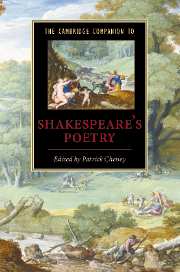Book contents
- Frontmatter
- Introduction: Shakespeare’s poetry in the twenty-first century
- 1 Shakespeare and the development of English poetry
- 2 Rhetoric, style, and poetic form
- 3 Print and manuscript
- 4 Venus and Adonis
- 5 The Rape of Lucrece
- 6 The Passionate Pilgrim and ‘The Phoenix and Turtle’
- 7 The Sonnets
- 8 A Lover’s Complaint
- 9 Poetry, politics, and religion
- 10 Love, beauty, and sexuality
- 11 Shakespeare and classicism
- 12 Poetry in Shakespeare’s plays
- 13 Poetry and performance
- 14 Reception and influence
- Reference works on Shakespeare’s poetry
- Index
9 - Poetry, politics, and religion
Published online by Cambridge University Press: 28 May 2007
- Frontmatter
- Introduction: Shakespeare’s poetry in the twenty-first century
- 1 Shakespeare and the development of English poetry
- 2 Rhetoric, style, and poetic form
- 3 Print and manuscript
- 4 Venus and Adonis
- 5 The Rape of Lucrece
- 6 The Passionate Pilgrim and ‘The Phoenix and Turtle’
- 7 The Sonnets
- 8 A Lover’s Complaint
- 9 Poetry, politics, and religion
- 10 Love, beauty, and sexuality
- 11 Shakespeare and classicism
- 12 Poetry in Shakespeare’s plays
- 13 Poetry and performance
- 14 Reception and influence
- Reference works on Shakespeare’s poetry
- Index
Summary
How should we read Shakespeare's poetry in terms of early modern English political ideas and religious beliefs? Shakespeare must have had political views, although there is a long critical tradition of assuming that his works exist as monuments for all time, beyond the exigencies of their moment of production. He also must have had some form of religious upbringing and, perhaps, adhered to a particular religious belief in his adult life. The problem is how to relate what we suspect were Shakespeare's views and beliefs to the poems. Or, to open out the question rather more carefully, how to read the works in terms of the religious and political ideas, images, and discourses that were in circulation in the late sixteenth and early seventeenth centuries. Shakespeare's poems may have had meanings that he did not, or could not, fully control.
Scholars of early modern politics and religion constantly warn readers that separating beliefs is a complicated task from the literary evidence that survives. Often Protestant and Catholic writers used the same conventions, making it hard to tell them apart as easily as we would like. Writers borrowed conventions, such as that of weeping as a form of religious ecstasy; imitated dominant poetic styles and models associated with one particular form of religious persuasion (especially that of Spenser, the pre-eminent Protestant poet of Elizabethan England); and often sought to minimize differences in the hope of religious unity, rather than emphasize the fact that the church had split apart. Moreover, Catholic writers frequently sought to disguise their beliefs so that they could be read only by readers of the same faith, suggesting that an absence of overtly Christian words and images does not necessarily indicate an absence of religious faith.
- Type
- Chapter
- Information
- The Cambridge Companion to Shakespeare's Poetry , pp. 161 - 180Publisher: Cambridge University PressPrint publication year: 2007



